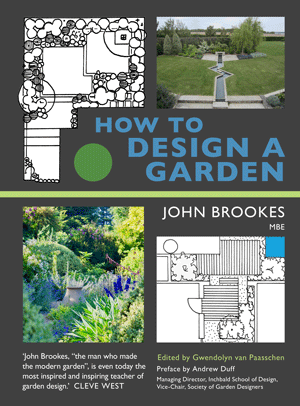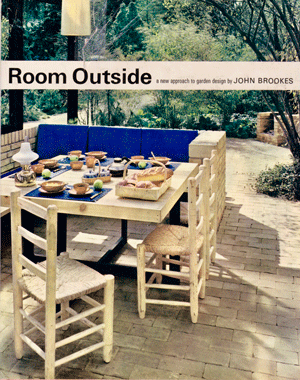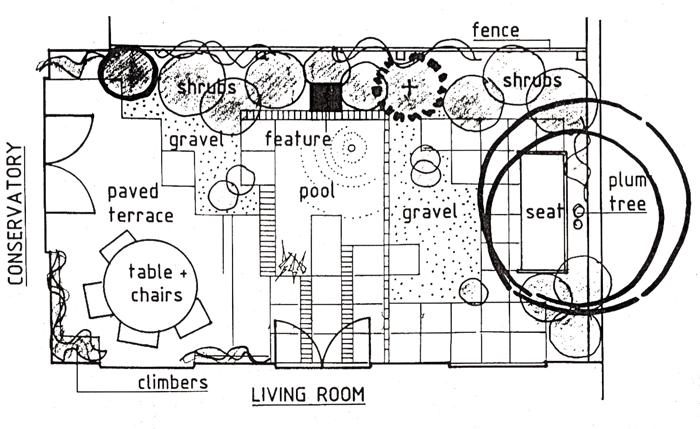Review: How to Design a Garden
 Sandy Felton reviews ‘How to Design a Garden’, a new compilation of the writings and thoughts of the late John Brookes MBE.
Sandy Felton reviews ‘How to Design a Garden’, a new compilation of the writings and thoughts of the late John Brookes MBE.
In the 1960s, John Brookes MBE (1933-2018) revolutionised garden design with a new design philosophy that was rooted in the notion that “gardens are about the people who live in them”.
John has always been a favourite designer of mine and so I was delighted to see this new book edited by Gwendolyn van Paasschen – ‘How to Design a Garden‘ – bringing together the very best of his writing, lectures, vision and down-to-earth common sense, that has inspired generations of gardeners. The book brings together pieces reflecting john’s convictions, expressed in his own voice, aimed sometimes at students, sometimes at colleagues, sometimes homeowners. As Gwendolyn points out his voice could sometimes be humorous, cantankerous, patient but always full of conviction.
The very first design book I purchased was by John and I also had the privilege of interviewing him, finding him entertaining, with a sharp wit and thoughtful. If I’m honest, I was more than a little in awe of him, such was his reputation but that interview was one of the most rewarding and entertaining I have ever done.
 His first book ‘A Room Outside’ (1969) included the then novel idea that people of all income levels could have designed and fashionable gardens tailored to their needs, low-maintenance and beautiful.
His first book ‘A Room Outside’ (1969) included the then novel idea that people of all income levels could have designed and fashionable gardens tailored to their needs, low-maintenance and beautiful.
In the years that followed, John inspired hundreds of future designers and gardeners, became a celebrated teacher, lecturer, author and award-winning designer and was recognised with an MBE awarded ‘for services to horticulture in the UK and overseas’ in 2004. Over his lifetime he was to receive many accolades and awards although, as Gwendolyn points out in the Foreword, he always kept his feet steadfastly on the ground. He loved his students, his clients and the challenges of each new site and his gift of combining simplicity and practicality with excellent design, endeared him to many.
John taught and lectured throughout the world and through his lectures, writing and media appearances, became regarded as the ‘king’ and ‘godfather’ of garden and landscape design.
In the Preface, Andrew Duff, Managing Director of the Inchbald School of Design and Vice-Chair of the Society of Garden Designers, points out that John was determined to demystify what most designers had spent years clouding in the magic of being a garden designer. He points out that Brookes, ‘could read a garden in the same way others can master a landscape in oil paint‘. His grid system translated the language of the house across the landscape and in this book we find his basic lessons aimed at designers and homeowners with lots of fundamental advice for both.
Each page resonates with John’s advice and vision. For him to drive by or go by rail to get a feel for the landscape was important, its topography, flat or rolling, mountainous or cultivated, forested or wet. He would then take a look at a survey map of the area to note the names of villages, field names etc. It all gave him a sense of place and setting.
It was important too for John to preserve in some measure regional diversity urging homeowners to to help – it was all about the soil. He recoiled at turning everywhere into a garden centre manager’s dream of rockery, plastic pool, dwarf conifer and heather.
 He was heartened to see the increasing organic trends and the use of natural materials, especially in flower show gardens. He felt there was something astir which was different and exciting and we can only hope that he was right given the challenges of global warming and our hankering after instant gardens!
He was heartened to see the increasing organic trends and the use of natural materials, especially in flower show gardens. He felt there was something astir which was different and exciting and we can only hope that he was right given the challenges of global warming and our hankering after instant gardens!
I had a little laugh when he chided journalists who asked him what his favourite plant was and he would reply “Favourite for where?” I have been guilty of this on numerous occasions and was once kindly told off by one top designer who said that the question was rather like asking which of your children was your favourite! I haven’t done it since.
 John’s humour and his gift for simplicity and practicality ooze out of every page and certainly this is one book I would recommend for anyone interested in garden design as a career. For us everyday gardeners it is full of ideas, basics and thought-provoking messages, that make us think about our own spaces and what we are doing in them. For me, bringing together so many aspects of John’s writing in one place was sheer joy and I feel many will treasure this book and value John’s design advice and philosophy which remains completely relevant and forward looking today. (John pictured left)
John’s humour and his gift for simplicity and practicality ooze out of every page and certainly this is one book I would recommend for anyone interested in garden design as a career. For us everyday gardeners it is full of ideas, basics and thought-provoking messages, that make us think about our own spaces and what we are doing in them. For me, bringing together so many aspects of John’s writing in one place was sheer joy and I feel many will treasure this book and value John’s design advice and philosophy which remains completely relevant and forward looking today. (John pictured left)
The book has two important key themes – environmental sustainability and a focus on the local vernacular. His thoughts demonstrate how advanced he was at the time and how his teaching remains so relevant to garden-makers today. The book is divided into five parts and covers advice to homeowners, designers and reflections on the garden in its setting and in our environment. The art of garden design and how to design and the craft of gardening are all covered in detail.
John designed gardens and landscapes all over the world. He founded schools of design in Japan, Chile and Argentina and, most famously, the Clock House School of Design at Denmans, West Sussex. He lived at Denmans until his death in 2018. He has been the inspiration and mentor for many of the UK’s current top designers.
Gwendolyn van Paasschen is a garden designer and writer. She is chair of the John Brookes Denman Foundation, which is dedicated to perpetuating John Brookes’ design legacy and to the preservation of Denmans Garden. Proceeds from the book will go to the John Brookes-Denmans Foundation.
‘How to Design a Garden‘ by John Brookes MBE, edited by Gwendolyn van Paasschen is in paperback at £20 and published by Pimpernel Press Ltd. For information on Denmans please visit www.denmans.org
Photo credits: All images ©John Brookes-Denmans Foundation/Pimpernel Press

